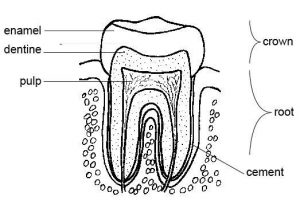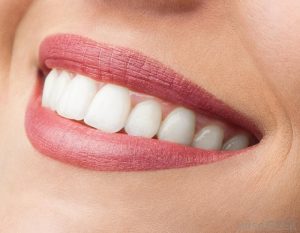Dental whitening procedures or more commonly called “Dental Bleaching” have been around for many years now. While the in office systems are very effective. They can lighten the shade of your teeth 4-6 shades in about one hour but over time the teeth tend to get yellow again necessitating the need to re-whiten them. Often the question comes up “Why?” The answer is two-fold. It lies in the anatomy of teeth as well as what we eat.
First look at this simple diagram of a tooth.
At over 90% mineralized, enamel is the hardest substance in the human body. It is white in color but porous. Dentin, which makes up the bulk of the tooth is only 45% mineralized and has a natural yellow hue. The cells that nourish the dentin are in the pulp chamber. Over a lifetime they tend to grow inward laying down more yellow dentin. Thus over a lifetime the hollow pulp chamber gets smaller as the tooth gets more dentin. This is one of your body’s mechanism to compensate for tooth wear as it cannot make new enamel. As you enamel wears, this alone can change the color over time. Even if you have your teeth whitened once, this process continues. In addition if you had taken any tetracycline antibiotics when these teeth were developing the antibiotic unfortunately interacted with the developing tooth germ to produce a darker tooth.
The second determinate is your diet and oral habits. As mentioned enamel is porous. This means that it has the ability to retain stains. If your diet consisted of water and white rice this would not be an issue. Smoking as well as dark colored food and drink can stain these surfaces. It is not just adults that can have this happen. I have seen it in children as well. Grape jelly and other dark stained cooked fruits seem to be the culprits here. Just because you have had your teeth whitened in the past does not stop this process.
Fortunately dental whitening is readily available and may be repeated. Over the counter products such as white strips only combat the staining or “extrinsic” stain. The professional dental whitening process will combat not only the extrinsic staining but the “intrinsic” or yellow staining of the dentin. As you may know there are two types of professional dental whitening. The in-office systems as well as the tray systems. While they both work, the biggest difference is that the in-office systems are faster. As stated, they take about an hour versus about two weeks for the tray systems.
In repeat whitening the process is the same. Can there be sensitivity? In the past, after treatment teeth tended to be sensitive to cold for a few days. The reason for this is simple. As mentioned above teeth are porous and the dentin is naturally packed with tiny tubules that communicate with the pulp. Once cleaned out there was indeed a tendency for some sensitivity. The good news is that this no longer seems to be the case! There are new formularies of the whitening agents that incorporate the same desensitizers used in some toothpastes such as Sensodyne. This means that it is very rare for this to happen anymore and if it does the sensitivity tends to pass very quickly.
In the world of dentistry in an effort to make what we do more comfortable for the patients the materials and techniques are being reformulated and changing all the time. This is but one small example. Whether you are considering dental whitening for the first time or want to rejuvenate your smile professional dental whitening is a readily available and economic process that is even more comfortable than it was even just a few years ago.

